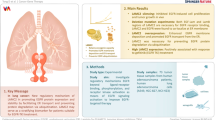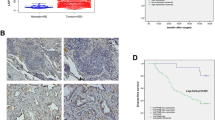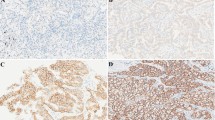Abstract
Objective
To investigate whether laminin 5 (LN5) might be a predictor in lung cancer patient treated with gefitinib and estimate the underlying mechanisms.
Methods
LN5 and epidermal growth factor receptor (EGFR) mRNA expression level were detected in the tumor tissues of lung cancer patients who underwent surgery resection prior to gefitinib treatment. EGFR exon 19 and 21 mutation status was also detected in these specimens. The association between LN5, EGFR mRNA expression level, EGFR mutation and gefitinib treatment response were evaluated. In vitro study were carried by adding exogenous LN5 and gefitinib to A549 lung cancer cell line, and Western-blotting was performed to investigate the phosphorylation level of EGFR, Ak, and Erk.
Results
The disease control rate according to LN5 mRNA level was 52.9% for the below cutpoint group, and 17.6% for the above cut-point (P = 0.009). The in vitro study showed that exogenous LN5 can neutralize the inhibition of phosphor-Akt by gefitinib.
Conclusion
Patients with lower LN5 mRNA level would likely benefit from gefitinib. In vitro study indicated that the inhibition of Akt induced by gefitinib might be reversed by LN5. These results provide important insights into the molecular mechanisms underlying sensitivity to gefitinib in lung cancer patients.
Similar content being viewed by others
References
Miyazaki K. Laminin-5 (laminin-332): Unique biological activity and role in tumor growth and invasion. Cancer Sci, 2006, 97: 91–98.
Fukai Y, Masuda N, Kato H, et al. Correlation between laminin-5 gamma2 chain and epidermal growth factor receptor expression in esophageal squamous cell carcinomas. Oncology, 2005, 69: 71–80.
Moriya Y, Niki T, Yamada T, et al. Increased expression of laminin-5 and its prognostic significance in lung adenocarcinomas of small size. An immunohistochemical analysis of 102 cases. Cancer, 2001, 91: 1129–1141.
Fukuoka M, Yano S, Giaccone G, et al. Multi-institutional randomized phase II trial of gefitinib for previously treated patients with advanced non-small cell lung cancer. J Clin Oncol, 2003, 21: 2237–2246.
Yano S, Kanematsu T, Miki T, et al. A report of two bronchioloalveolar carcinoma cases which were rapidly improved by treatment with the epidermal growth factor receptor tyrosine kinase inhibitor ZD1839 (“Iressa”). Cancer Sci, 2003, 94: 453–458.
Nakagawa K, Tamura T, Negoro S, et al. Phase I pharmacokinetic trial of the selective oral epidermal growth factor receptor tyrosine kinase inhibitor gefitinib (“Iressa”, ZD1839) in Japanese patients with solid malignant tumors. Ann Oncol, 2003, 14: 922–930.
Lynch TJ, Bell DW, Sordella R, et al. Activating mutations in the epidermal growth factor receptor underlying responsiveness of non-smallcell lung cancer to gefitinib. N Engl J Med, 2004, 350: 2129–2139.
Paez JG, Janne PA, Lee JC, et al. EGFR mutations in lung cancer: correlation with clinical response to gefitinib therapy. Science, 2004, 304: 1497–1500
Pao W, Miller V, Zakowski M, et al. EGF receptor gene mutations are common in lung cancers from ‘never smokers’ and are associated with sensitivity of tumors to gefitinib and erlotinib. Proc Natl Acad Sci USA, 2004, 101: 13306–13311.
Kosaka T, Yatabe Y, Endoh H, et al. Mutations of the epidermal growth factor receptor gene in lung cancer: biological and clinical implications. Cancer Res, 2004, 64: 8919–8923.
Tokumo M, Toyooka S, Kiura K, et al. The relationship between epidermal growth factor receptor mutations and clinicopathologic features in non-small cell lung cancers. Clin Cancer Res, 2005, 11: 1167–1173.
Shigematsu H, Lin L, Takahashi T, et al. Clinical and biological features associated with epidermal growth factor receptor gene mutations in lung cancers. J Natl Cancer Inst, 2005, 97: 339–346.
Huang SF, Liu HP, Li LH, et al. High frequency of epidermal growth factor receptor mutations with complex patterns in non-small cell lung cancers related to gefitinib responsiveness in Taiwan. Clin Cancer Res, 2004, 10: 8195–8203.
Yang SH, Mechanic LE, Yang P, et al. Mutations in the tyrosine kinase domain of the epidermal growth factor receptor in non-small cell lung cancer. Clin Cancer Res, 2005, 11: 2106–2110.
Kim KS, Jeong JY, Kim YC, et al. Predictors of the response to gefitinib in refractory non-small cell lung cancer. Clin Cancer Res, 2005, 11: 2244–2251.
Han SW, Kim TY, Hwang PG, et al. Predictive and prognostic impact of epidermal growth factor receptor mutation in non-small cell lung cancer patients treated with gefitinib. J Clin Oncol, 2005, 23: 2493–2501.
Mitsudomi T, Kosaka T, Endoh H, et al. Mutations of the epidermal growth factor receptor gene predict prolonged survival after gefitinib treatment in patients with non-small cell lung cancer with postoperative recurrence. J Clin Oncol, 2005, 23: 2513–2520.
Cortes-Funes H, Gomez C, Rosell R, et al. Epidermal growth factor receptor activating mutations in Spanish gefitinib-treated non-smallcell lung cancer patients. Ann Oncol, 2005, 16: 1081–1086.
An SJ, Nie Q, Chen ZH, et al. KDR expression is associated with the stage and cigarette smoking of the patients with lung cancer. J Cancer Res Clin Oncol, 2007, 133: 635–642.
Zhang GC, Lin JY, Wang Z, et al. Epidermal growth factor receptor double activating mutations involving both exons 19 and 21 exist in Chinese non-small cell lung cancer patients. Clin Oncol, 2007, 499–506.
Therasse P, Arbuck SG, Eisenhauer EA, et al. New guidelines to evaluate the response to treatment in solid tumors. J Natl Cancer Inst, 2000, 92: 205–216.
Cappuzzo F, Hirsch FR, Rossi E, et al. Epidermal growth factor gene and protein and gefitinib sensitivity in non-small cell lung cancer. J Natl Cancer Inst, 2005, 97: 643–655.
Janne PA, Engelman JA, Johnson BE. Epidermal growth factor receptor mutations in non-small cell lung cancer: implications for treatment and tumor biology. J Clin Oncol, 2005, 23: 3227–3234.
Hirsch FR, Varella-Garcia M, Bunn JPA, et al. Molecular predictors of outcome With gefitinib in a phase III placebo-controlled study in advanced non-small cell lung cancer. J Clin Oncol, 2006, 24: 5034–5042.
Noro R, Gemma A, Kosaihira S, et al. Gefitinib (IRESSA) sensitive lung cancer cell lines show phosphorylation of Akt without ligand stimulation. BMC Cancer, 2006, 6: 277.
Giannelli G, Azzariti A, Fransvea E, et al. Laminin-5 offsets the efficacy of gefitinib (’Iressa’) in hepatocellular carcinoma cells. Br J Cancer, 2004, 91: 1964–1969.
Yurchenco PD, Cheng YS. Self-assembly and calcium-binding sites in laminin A three-arm interaction model. J Biol Chem, 1993, 268: 17286–17299.
Engel J. Domain organizations of modular extracellular matrix proteins and their evolution. Matrix Biol, 1996, 15: 295–299.
Cappuzzo F, Magrini E, Ceresoli GL, et al. Akt phosphorylation and gefitinib efficacy in patients with advanced non-small cell lung cancer. J Natl Cancer Inst, 2004, 96: 1133–1141.
Author information
Authors and Affiliations
Corresponding author
Additional information
Supported by grants from the National Natural Science Foundation of China (No. 30772531), Guangdong Provincial Medical Science and Technology Research Foundation (No. B2006001) and China Postdoc toral Science Foundation (No. 20060400212).
Rights and permissions
About this article
Cite this article
An, S., Zhu, J., Chen, Z. et al. Elevated expression level of laminin 5 may be a negative predictive factor for the response to gefitinib in lung cancer patients. Chin. -Ger. J. Clin. Oncol. 7, 677–681 (2008). https://doi.org/10.1007/s10330-008-0140-x
Received:
Revised:
Accepted:
Published:
Issue Date:
DOI: https://doi.org/10.1007/s10330-008-0140-x




